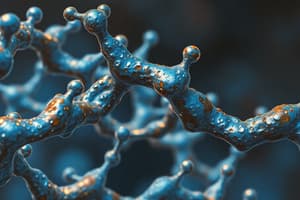Podcast
Questions and Answers
What is the function of ATP in the body?
What is the function of ATP in the body?
- To synthesize glucose
- To provide energy for endergonic reactions (correct)
- To catalyze chemical reactions
- To store metal ions
Which type of enzymes require metal ions for their activity?
Which type of enzymes require metal ions for their activity?
- Vitamin B complex enzymes
- Co-enzymes
- Metallo-enzymes (correct)
- Ion-activated enzymes
What is the term used to describe ATP, ADP, and other molecules that transfer energy?
What is the term used to describe ATP, ADP, and other molecules that transfer energy?
- High-energy bonds
- Energy currency (correct)
- Co-factors
- Co-enzymes
What is the type of bond found in the ATP molecule?
What is the type of bond found in the ATP molecule?
Which enzyme is an example of an ion-activated enzyme?
Which enzyme is an example of an ion-activated enzyme?
What is the term used to describe co-enzymes and metal ions?
What is the term used to describe co-enzymes and metal ions?
What is the non-protein part of an enzyme called?
What is the non-protein part of an enzyme called?
Which of the following is a characteristic of co-enzymes?
Which of the following is a characteristic of co-enzymes?
What is the name of the protein part of an enzyme when it is combined with a co-enzyme?
What is the name of the protein part of an enzyme when it is combined with a co-enzyme?
What is the function of co-enzymes in the first group of co-enzymes?
What is the function of co-enzymes in the first group of co-enzymes?
What is the reduced form of NAD+?
What is the reduced form of NAD+?
What is the role of NAD+ in the reaction of lactate to pyruvate?
What is the role of NAD+ in the reaction of lactate to pyruvate?
What is the function of the second group of co-enzymes?
What is the function of the second group of co-enzymes?
What is the structure of NAD+?
What is the structure of NAD+?
Flashcards are hidden until you start studying
Study Notes
Co-enzymes
- Co-enzymes are non-protein parts of enzymes, also known as prosthetic groups, which are heat stable.
- The protein part of the enzyme is called the apo-enzyme, which is heat labile.
- When combined, the apo-enzyme and co-enzyme form the holo-enzyme.
Classification of Co-enzymes
- Co-enzymes can be divided into two groups:
- Those involved in reactions catalyzed by oxidoreductases, donating or accepting hydrogen atoms or electrons.
- Those involved in reactions transferring groups other than hydrogen.
First Group of Co-enzymes
- In this group, the change in the substrate is counter-balanced by the co-enzyme.
- Examples include NAD+-NADPH, FAD-FADH2, and FMN-FMNH2.
- NAD+ (Nicotinamide Adenine Dinucleotide) is a co-enzyme synthesized from Nicotinamide, a vitamin B complex member.
- The structure of NAD+ is Nicotinamide-RiboseP-P-Ribose-Adenine.
- NAD+ plays a crucial role in the reversible reaction of lactate to pyruvate, catalyzed by the enzyme lactate dehydrogenase.
- During this reaction, two hydrogen atoms are removed from lactate, with one hydrogen and two electrons accepted by NAD+ to form NADH.
Second Group of Co-enzymes
- These co-enzymes are involved in reactions transferring groups other than hydrogen.
- Examples include co-enzymes that belong to the vitamin B complex group.
- A few examples are given in Table 5.1.
Adenosine Triphosphate (ATP)
- ATP is considered the energy currency in the body.
- ATP was first isolated by Fiske and Subba Row in 1926, and its importance in muscle contraction was shown by Lohmann in 1929.
- The second and third phosphate bonds in ATP are 'high energy' bonds.
- During the oxidation of foodstuffs, energy is released and stored as chemical energy in the form of ATP.
- Endergonic reactions are carried out with the help of energy released from ATP hydrolysis.
Metallo-enzymes
- Metallo-enzymes are enzymes that require certain metal ions for their activity.
- Examples include enzymes that require copper, iron, or zinc ions.
- In some cases, the metal ion is tightly bound with the enzyme, while in others, the enzyme may be active without the metal ion but is enhanced by its presence.
Co-factors
- Co-factors are a collective term that includes co-enzymes and metal ions.
- Co-enzymes are organic co-factors.
Studying That Suits You
Use AI to generate personalized quizzes and flashcards to suit your learning preferences.




